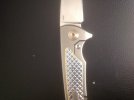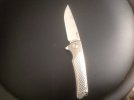- Joined
- Mar 29, 2019
- Messages
- 1
Hey y'all. I'm new to the forum, but have been reading posts for a long time and really enjoy the content. Now I have a question for you knife enthusiasts.
I just recently purchased a new, Reate Mini Horizon D, but was unhappy with the lock up and returned it. I asked the dealer if he had others with better lockup, but he stated the other Horizons were similar to mine, locking up at approx 10% and he sent me a photo of one. The lock bar on both knives was just barely under the blade. To close it, I just nudged it lightly to the left and the lock bar disengaged. There was basically no resistance to disengaged the lock bar.
My other Chinese knives (We & Kizer) all lock up at between 25% to 35%.
Is the 10% or so lockup on the Reates acceptable?
I just recently purchased a new, Reate Mini Horizon D, but was unhappy with the lock up and returned it. I asked the dealer if he had others with better lockup, but he stated the other Horizons were similar to mine, locking up at approx 10% and he sent me a photo of one. The lock bar on both knives was just barely under the blade. To close it, I just nudged it lightly to the left and the lock bar disengaged. There was basically no resistance to disengaged the lock bar.
My other Chinese knives (We & Kizer) all lock up at between 25% to 35%.
Is the 10% or so lockup on the Reates acceptable?
Last edited:




